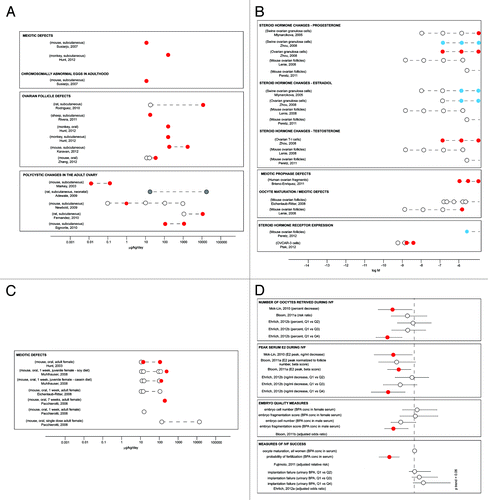Figures & data
Table 1. Endpoints demonstrating non-monotonicity in in vitro and in vivo low dose studies of BPA
Table 2. Examples of adverse endpoints in laboratory animals
Figure 1. Low dose effects of BPA on liver enzymes. (A) In vitro studies examining the effects of BPA on hepatocyte enzyme production and production of reactive oxygen species (ROS). (B) Four in vivo laboratory rodent studies examined the effects of low dose BPA exposures on production of liver enzymes. (C) Summary of epidemiology studies examining effects of BPA on liver enzymes. Open circles indicate applied doses that did not induce significant effects (A and B) or populations that were unaffected (C). Red circles indicate doses that significantly increased the measure of interest (A and B) or populations that were significantly affected (C). Blue circles indicate doses that significantly decreased the measure of interest (A).
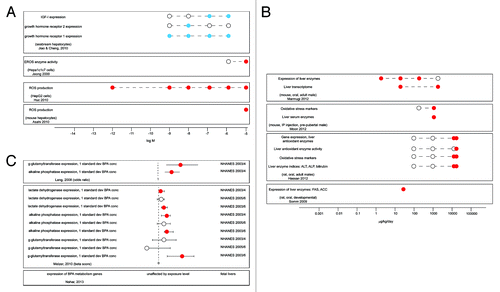
Figure 2. Low dose effects of BPA on insulin signaling. (A) Insulin responses in cultured pancreatic islets. (B) Low dose effects of BPA on insulin levels in lab rodents. (C) Summary of epidemiology studies examining relationships between type II diabetes and urinary concentrations of BPA. Open circles indicate applied doses that did not induce significant effects (A and B) or populations that were unaffected (C). Red circles indicate doses that significantly increased the measure of interest (A and B) or populations that were significantly affected (C). Blue circles indicate doses that significantly decreased the measure of interest (B).
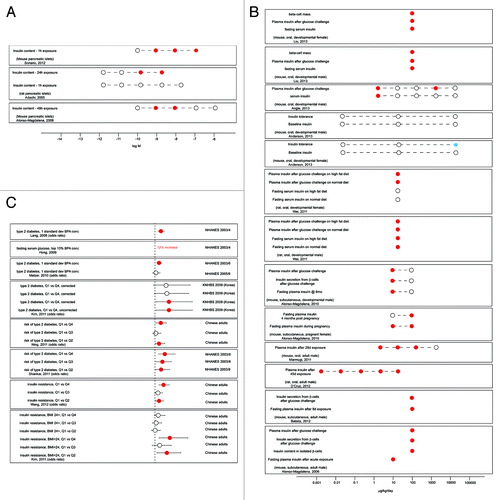
Figure 3. Low dose effects of BPA on select neurobehaviors. (A) Effects of BPA on anxiety behaviors in the open field test. (B) Effects of BPA on spatial learning and memory in rodents in the Morris water maze. (C) Epidemiology studies examining relationships between maternal urinary BPA concentrations and neurodevelopmental parameters in children. Open circles indicate applied doses that did not induce significant effects (A and B) or populations that were unaffected (C). Red circles indicate doses that significantly increased the measure of interest (A) or populations that were significantly affected (C). Blue circles indicate doses that significantly decreased the measure of interest (A and B).
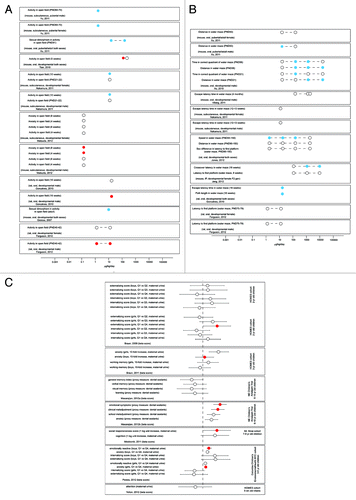
Figure 4. Low dose BPA alters the response of the mammary gland to environmental challenges. (A) In vitro studies reveal that BPA exposures confer chemotherapeutic resistance in mammary cells. (B) Low doses of BPA induce preneoplastic and neoplastic lesions in the rodent mammary gland, and alter adult challenges with carcinogenic agents. Open circles indicate applied doses that did not induce significant effects (A and B). Blue circles indicate doses that significantly decreased the measure of interest (A). Red circles indicate doses that significantly increased the measure of interest (B). Gray circles indicate doses that induced the adverse effect noted, but statistics were not performed.
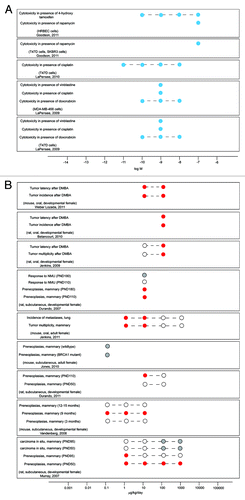
Figure 5. Low dose effects of BPA on the ovary. (A) Effects of developmental exposures on ovarian endpoints, including adverse effects that manifest in adulthood. (B) Summary of in vitro studies showing effects of BPA on hormone production and enzyme activity in ovarian cells. (C) Effects of adult exposures on ovarian endpoints in rodents. (D) Summary of epidemiology studies examining relationships between BPA exposure metrics and ovarian response in women undergoing IVF. Open circles indicate applied doses that did not induce significant effects (A–C) or populations that were unaffected (D). Red circles indicate doses that significantly increased the measure of interest (A–C) or populations that were significantly affected (D). Blue circles indicate doses that significantly decreased the measure of interest (B). Gray circles indicate doses that induced the adverse effect noted, but statistics were not performed.
